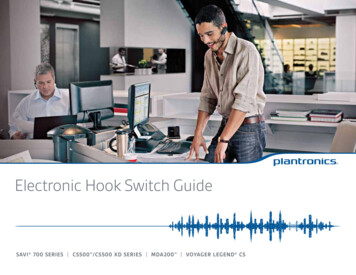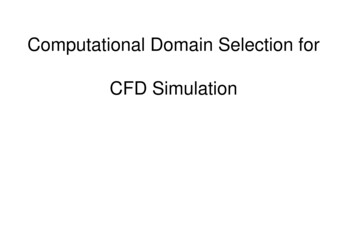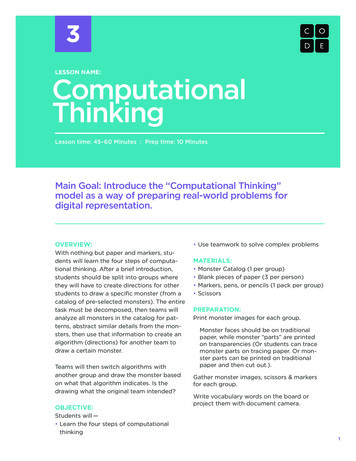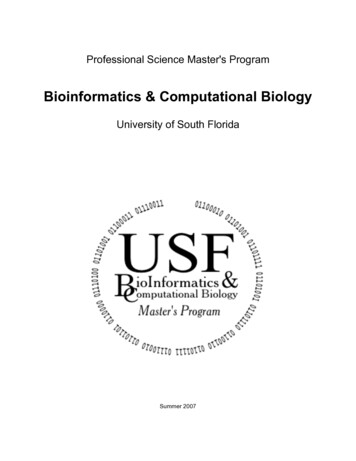
Transcription
Use of Computational Models toPredict the Toxicity of CompoundsReleased from Medical DeviceMaterialsRon BrownRisk Science Consortium, LLCMDCPSS and CTSS Webinar: Practical Application of Computational Models to PredictRelease Kinetics and Toxicity of Compounds Released from Medical Devices1
Because of time restrictions, it’s not possible todiscuss all aspects of using computational models fortoxicity assessment of medical devices.Caveats Goals of this presentation are: mention some new and potentially usefulprograms that you may not be aware of provide pointers to online resources to allow youto investigate these online tools in more detail atyour convenience. Apologies to our friends from the CTSS, but thewebinar will primarily focus on tools for the safetyassessment of medical devices.2
Overview Explore updates to open sourcecomptox models Review the need for expert reviewof model-derived predictions Provide recommendations foradditional training in the field Provide update on new sources oftoxicity information3
Overview Explore updates to open sourcecomptox models Review the need for expert review ofmodel-derived predictions Provide recommendations foradditional training in the field Provide update on new sources oftoxicity information4
Why do weneed to usecomputationalmodels?Have dataDon’t have data Ideally have data toestimate exposure andderive Tolerable Intake(TI) values forcompounds releasedfrom device materials. Use conservativedefault assumptions(e.g., worst caseexposure estimate, TTCas a default TI) In reality, exposure andtoxicity data are notavailable for manycompounds releasedfrom device materials. Use computationalmodels to estimateexposure and toxicity.5
What does the CDRH BiocompatibilityGuidance document say about the use ofcomputational models?G. CarcinogenicityIn the absence of experimentally derivedcarcinogenicity information, structureactivity relationship (SAR) modeling forthese materials may be needed regardlessof the duration of contact, to betterunderstand the carcinogenicity potentialfor these materials.6
Determine whether it is necessary to use a TTC valueintended to be protective for carcinogenic effects or if it’spossible to use a Cramer Class value as a default TI.How do wetypically usemodel-derivedestimates ofgenotoxicity/carcinogenicity?From ISO 21726:2019 When experimental data or model-derived predictionssuggest that an identified constituent is not likely to havecarcinogenic effects (e.g. negative mutagenicity data ornegative results in at least two computational models thatoperate using different approaches; system-based andstatistically based), then categorizing the constituent intoits appropriate Cramer Class and use of the correspondingTTC value is recommended7
Very little guidance offered in the CDRHBiocompatibility Guidance document onwhich SAR models to useHow do we usemodel-derivedestimates ofgenotoxicity/carcinogenicity?Refer to ICH M7 “Assessment and Control of DNAReactive (Mutagenic) Impurities in Pharmaceuticals toLimit Potential Carcinogenic Risk” available limit-potential for information on use of the TTC andstructure activity relationship (SAR) modeling to addressgenotoxicity and carcinogenicity issues within a riskmanagement process.8
Guidance in ICH M7 on which models to useA computational toxicology assessment shouldbe performed using Quantitative StructureActivity Relationship ((Q)SAR) methodologiesthat predict the outcome of a bacterialmutagenicity assay (Ref. 6). Two (Q)SARprediction methodologies that complement eachother should be applied. One methodologyshould be expert rule-based, and the secondmethodology should be statistical-based.9
Expert systemsExamples ofexpertsystems andstatisticallybasedmodelsStatistically basedmodels Toxtree Lazar OECD Toolbox TOPKAT OncoLogic Sarah Nexus DEREK Nexus VEGA EPA T.E.S.TExpert system and statistical modules CASE Ultra (available through Danish QSAR database) Leadscope (available through Danish QSAR database)10
ToxtreeVersion 3.1.0 includesRevised Cramer DecisionTree moduleExample of Cramer Classdesignationsforformaldehyde.Inconsistent results arepossible. Not clear thatone approach is preferredby regulatory agenciesover another.11
Using Toxtreeto assesscarcinogenicpotential ofnongenotoxiccarcinogensCDRH Biocompatibility GuidanceBecause there are carcinogens that are not genotoxins andcarcinogenesis is multifactorial, the assessment ofcarcinogenicity should not rely solely on genotoxicityinformation.How should we assess the potential for carcinogenicity tooccur by nongenotoxic mechanisms? Conduct a search of the literature to determine potential for thecompound to exert a carcinogenic effect via a nongenotoxic mechanism Toxtree can be used as a tool to help determine nongenotoxic carcinogensExample: carbon tetrachloride12
Version 4.4 released in February, 2020; update 4.4.1 in AprilNew features New Simplified Toolbox interface Development of a Toolbox web repository where different modules which could be docked toToolbox are stored Development of Toolbox repository client within the QSAR Toolbox which manages the docking ofexternal modules via direct connection to web repository or uploading from the local computer Possibility to “unlock” the ECHA REACH database export in Toolbox which allows exporting of dataafter accepting the terms and condition for usage.13
14
New versionof OncoLogicis availableJanuary, 202015
Expert systemsExamples ofexpertsystems andstatisticallybasedmodelsStatistically basedmodels Toxtree Lazar OECD Toolbox TOPKAT OncoLogic Sarah Nexus DEREK Nexus VEGA EPA T.E.S.TExpert system and statistical modules CASE Ultra (available through Danish QSAR database) Leadscope (available through Danish QSAR database)16
LAZAR(LazyStructureActivityRelationships) makes toxicity predictions forchemical structures. It uses an automated andreproducible read across algorithm and showsrationales for predictions, applicability domainestimations and validation results in a cleargraphical interface17
qsar.food.dtu.dk/18
EPA T.E.S.T. isavailablethroughCompToxChemicalsDashboard19
CDRH Biocompatibility Guidance (2020)The use ofcomputationalmodels alonefor theassessment ofpotentialcarcinogenicitymay not besufficientEvaluate the genotoxicity and carcinogenicity potentialof the chemicals, including: a thorough literature review with identified searchterms, assessment of any evidence of carcinogenicity fromlong-term in vivo animal studies (e.g. inflammation,pre-neoplastic lesions, or tumor findings in animalstudies), the relevance of animal data to assess risks in humans,and assessment of human data from epidemiological studiesif available or any other relevant long-term clinicalstudy findings, including susceptible population and lifestages, and device implant site and propensity of thesite to develop local tumors.57,5820
Use of QSARmodels topredict thegenotoxicity/carcinogenicityof tentativelyor partiallyidentifiedcompoundsNontargeted analysis of extracts of medicaldevices often results in tentatively or partiallyidentified compounds.Can we use QSAR models to predict thegenotoxicity/carcinogenicity/toxicity of thesecompounds?Topic of debate and discussion. This approachmay not be accepted by CDRH in a regulatorysubmission.21
Overview Explore some new and existing opensource comptox models Review the need for expert review ofmodel-derived predictions Provide recommendations foradditional training in the field Provide update on new toxicityinformation sources22
Example ofNeed forExpert ReviewDon’t relysolely on theoutput ofQSAR models23
Need forexpert reviewof modelderivedpredictions24
Updates are available for Toxtree, OECD Toolbox, Oncologic.Take homemessages onthe use ofQSAR modelsfor the safetyassessment ofE&Lcompounds Cramer Class modules in Toxtree can return differing results.Toxtree can be useful for the assessment of carcinogenicity bynongenotoxic effects. EPA TEST is available through the EPA CompTox ChemicalsDashboard. Don’t accept the model-derived predictions without an expertreview of the results; often needed when the resulting MoS is 1 or when model-derived predictions of carcinogenicity arenot convergent. Model-derived predictions of carcinogenicity alone are oftennot sufficient for the safety evaluation. Ideally, useexperimentally derived data on genotoxicity along withmodel-derived predictions to inform decisions about potentialcarcinogenicity.25
There is no consensus approach for Read Across that has beenrecognized by CDRH in a standard or guidance document;however, CDRH may consider/accept this approach as a means toderive a PoD if it is supported with an adequate justification.Advice on theUse of ReadAcrossApproachesRecommendations Use well established approaches; don’t arbitrarily select astructural analog It’s best to use multiple approaches to make your case Show your work, side-by-side comparison tables are useful. Establish toxicological equivalency between the data poorcompound of interest and data rich structural analogs usingboth chemical and biological similarity26
Establish ChemicalSimilarityOpen sourceprograms forRead Acrossand ChemicalGroupingEstablishingBiologicalSimilarity GenRA GenRA NTP ICE PubChem ToxPrint Chemotyper EPA CompToxChemicals Dashboard –TOXCAST/Tox21 ChemACE AIM PubChem ChemMine OECD Toolbox QSAR models/expertsystems27
GenRA Tool in EPA CompTox Chemicals Dashboard28
GenRA willidentify closestanalogs based onstructure orbiological activity29
Obtaining in vitro data from TOXCAST/Tox21using EPA CompTox Chemicals Dashboard30
Useful Open Source Papers on GenRA and Read AcrossALTEX. 2019;36(3):462-465.31
Establish ChemicalSimilarityOpen sourceprograms forRead Acrossand ChemicalGroupingEstablishingBiologicalSimilarity GenRA GenRA NTP ICE PubChem ToxPrint Chemotyper EPA CompToxChemicals Dashboard –TOXCAST/Tox21 ChemACE AIM PubChem ChemMine OECD Toolbox QSAR models/expertsystems32
Use to establish similarity ofcompounds on the basis ofmolecular descriptors or physicalchemical properties33
Example of using NTP ICE to identify structural analogsTest chemical – Butyl-2ethylhexyl phthalateStructural analogs – seriesof phthalate estersUse PCA feature inChemical Characterizationmodule to identify closestanalogs on the basis ofstructure or physicalchemical properties34
Use of NTP ICE to visually define chemical spaceExample of using NTPICEtocomparechemical space ofVOCs released fromdevice materials andVOCs used to deriveinhalation TTC value.Thursday, August 5, 11 AM s.asp35
Additional source of information about NTP ICE36
37
38
39
Use ChemMine Tools to establish chemicalsimilarity between compounds40
There is no consensus approach for Read Across that has beenrecognized by CDRH in a standard or guidance document;however, CDRH may considered this approach if it is supportedbased by scientific evidence.Take homemessages onthe Use ofRead AcrossApproachesRecommendations Use well established approaches; don’t arbitrarily select astructural analog It’s best to use multiple approaches to make your case Show your work, side-by-side comparison tables are useful. Establish toxicological equivalency between the data poorcompound of interest and data rich structural analogs usingboth chemical and biological similarity41
Update toBMD models42
Exposuremodels43
Training OpportunitiesIVAMSS and CTSS Webinar: State of the Science:QSAR Modeling of Skin 05681a6ea/playbackSlides and recorded presentations can be found gram-app/session/1496244
45
Send questions orcomments to:QuestionsRon BrownRisk ScienceConsortiumriskscienceconsortium@gmail.com46
Informationresources Explore some new and existing opensource comptox models Review the need for expert review ofmodel-derived predictions Provide recommendations foradditional training in the field Provide update on new toxicityinformation sources47
Where do Ifind ? SMILES codes – PubChem Dose-Response data and existing HBELvalues – EPA CompTox ChemicalsDashboard, EFSA OpenFoodTox,COSMOS NG TD50 values – Lhasa CarcinogenicityDatabase TTC values – TTC Data Mart48
49
50
51
Lhasa Carcinogenicity Database52
53
Toolbox are stored Development of Toolbox repository client within the QSAR Toolbox which manages the docking of external modules via direct connection to web repository or uploading from the local computer Possibility to “unlock” the ECHA REACH database export i











